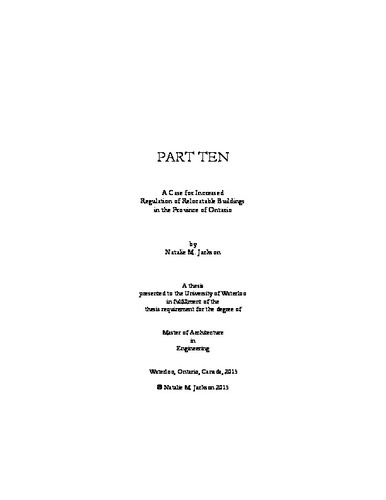| dc.description.abstract | Abstract:
This thesis addresses the role that building regulations and codes have in shaping the way that the
pre- fabricated building industry designs, manufactures and installs Relocatable Buildings (RB)
used within the Institutional, Commercial and Industrial (ICI) sectors. It looks at the history
and development of the Relocatable Building industry with particular focus on their application and
use in the Province of Ontario, within the larger North American context. Familiar typologies
under the umbrella of relocatable buildings include: Manufactured Homes, Emergency Shelters,
Portable Classrooms and Industrial Accommodations1. Of these categories, the latter two will be the
focus addressed within this work.
The majority of relocatable buildings are manufactured and constructed without the direct
involvement of the architectural profession. Many of these buildings barely meet the basic
requirements of health, safety, durability, and occupant comfort that is expected of contemporary
construction for all other occupied building typologies2. This problematic building type needs to
garner greater attention from designers, regulators and building officials in order to set in place
the framework for clearer regulatory guidelines and requirements for these structures. Such a
framework has the potential to lead to overall improvement of the quality of construction and
product delivery within this sector.
This thesis illustrates proposed modifications of the primary documents which set the current
regulatory framework for these buildings in Canada: the Canadian Standards Association (CSA) Z240
Standard for Manufactured Homes3; the Canadian Standards Association CSA A277 Standards for Factory
Built Buildings; the Ontario Building Code (OBC) 2012 edition4; and the National Building Code of
Canada (NBCC) 2010 edition5. Amendments amassed from existing precedent codes and model voluntary
standards, intend to increase and improve the baseline expectations and requirements of building
construction in this category with the intent of directly improving the quality of product being
generated by this billion dollar annual Canadian industry. The goal being that design and
construction improvements based on changes in regulation, extend to benefit the lives, and
day-to-day experiences, of users and occupants of these relocatable structures. This thesis
examines the potential, details and positive outcomes for revising the OBC to reflect the addition
of this new
chapter to the code.
1 www.modular.org Modular Building Institute
2 www.epa.gov US EPA Study on Portable Classrooms
3 www.csagroup.org Canadian Standards Association
4 www.mah.gov.on.ca Ontario Ministry of Municipal Affairs and Housing
5 www.nrc-cnrc.gc.ca/eng/solutions/advisory/codes_centre_index.html National Building Code of
Canada | en |

